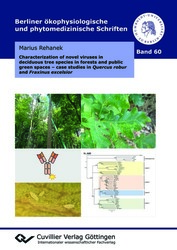| Departments | |
|---|---|
| Book Series (96) |
1377
|
| Nachhaltigkeit |
3
|
| Gesundheitswesen |
1
|
| Humanities |
2361
|
| Natural Sciences |
5403
|
| Mathematics | 229 |
| Informatics | 318 |
| Physics | 979 |
| Chemistry | 1362 |
| Geosciences | 131 |
| Human medicine | 243 |
| Stomatology | 10 |
| Veterinary medicine | 108 |
| Pharmacy | 147 |
| Biology | 835 |
| Biochemistry, molecular biology, gene technology | 121 |
| Biophysics | 25 |
| Domestic and nutritional science | 45 |
| Agricultural science | 1004 |
| Forest science | 201 |
| Horticultural science | 20 |
| Environmental research, ecology and landscape conservation | 148 |
| Engineering |
1788
|
| Common |
97
|
|
Leitlinien Unfallchirurgie
5. Auflage bestellen |
|
Advanced Search
Characterization of novel viruses in deciduous tree species in forests and public green spaces – case studies in Quercus robur and Fraxinus excelsior (Volume 60) (English shop)
Marius Rehanek (Author)Preview
Extract, PDF (470 KB)
Table of Contents, PDF (190 KB)
The health of plants in general and deciduous trees in particular is influenced by a variety of factors, including abiotic and biotic factors. Uncountable harmful organisms can lead to a weakening of deciduous trees and shrubs in forests and urban green, which are worth protecting due to their longevity and the invaluable ecosystem services they provide, as well as their high economic value.
In this context, plant viruses play a major role and must be considered. Due to their ability to affect the host metabolism for the purpose of their own replication, they can influence the vitality of trees, change their susceptibility to other stress factors and thus lead to economic and ecological losses.
In recent years, established technologies in the field of sequencing and bioinformatics have revealed the high abundance and enormous diversity of viruses in forest trees.
New viruses of the genus Emaravirus have been discovered in numerous hosts, including herbaceous and woody plants. Especially in deciduous trees, emaraviruses have become the most widespread virus group causing diseases in important species of temperate and boreal forests.
In this doctoral thesis, genetic and biological aspects of novel viruses were studied, with special focus on the emerging group of emaraviruses. Using the case studies common oak (Quercus robur L.) and common ash (Fraxinus excelsior L.), epidemiological studies revealed a wide distribution of common oak ringspot-associated virus (CORaV) and ash shoestring-associated virus (ASaV) in forest and urban trees. CORaV and ASaV can be differentiated from other pathogens based on specific leaf symptoms. With the help of a newly developed diagnostic ELISA, CORaV can be reliably detected serologically in diseased oak trees. A new species of rust mite is likely to be the vector for virus transmission. Based on the results considering the composition of emaraviral accessory proteins, the taxonomic order of the genus Emaravirus can be revised.
In addition to ASaV, cytorhabdoviruses were shown to frequently infect common ash in natural and managed forest sites. Genetic characterization provided evidence for two distinct cytorhabdovirus species affecting not only Fraxinus excelsior, but also manna ash (Fraxinus ornus) and red ash (Fraxinus pennsylvanica). Applying High-throughput sequencing (HTS) analyses, sequence information about novel viruses belonging to different families have been revealed.
The doctoral thesis provides new insights into the diverse virome of deciduous trees, thereby highlighting the demand for further studies on this fascinating group of pathogens. Their characterization and interaction with other abiotic and biotic stressors may serve as a basis for better disease management concepts of essential long-living trees in the future.
| ISBN-13 (Hard Copy) | 9783689527921 |
| ISBN-13 (eBook) | 9783689527938 |
| Final Book Format | A5 |
| Language | English |
| Page Number | 174 |
| Lamination of Cover | matt |
| Edition | 1. |
| Book Series | Berliner ökophysiologische und phytomedizinische Schriften |
| Volume | 60 |
| Publication Place | Göttingen |
| Publication Date | 2025-03-20 |
| General Categorization | Dissertation |
| Departments |
Natural Sciences
Biochemistry, molecular biology, gene technology Plant production |
| Keywords | antibody, ASaV, ash, bioinfonnatics, Bunyavirales, chlorotic ringspots, CORaV, cytorhabdoviru s, diagnosis, ELISA, emaravirus, epiderniology, Fimoviridae, forest trees, Fraxinus, genome organization, High-throughput sequencing, idaeovirus, leaf symptoms, mites, oak, nucleocapsid, nursery, pathogen, phylogeny, phytobiome, plant health, protein expression, Quercus, RNA, RT-PCR, seed orchard, serology, shoestring, symptomatology, taxonomy, transmission, urban trees, viral disease, viral protein Antikörper, ASaV, Bioinformatik, Blattsymptome, Bunyavirales, chlorotische Ringflecken, CORaV, Cytorhabdoviren, Diagnostik, Eiche, ELISA, Emarviren, Epidemiologie, Esche, Fadenblättrigkeit, Fimoviridae, Forstgehölze, Fraxinus, Genomorganisation, Hochdurchsatzsequenzierung. Idaeovirus, Milben, Nukleokapsid, Pathogen, Pflanzengesundheit, Phylogenie, Phytobiom, Proteinexpression, Quercus, RNA, RT-PCR, Samenpiantage, Sämlingsspenderanlage, Serologie, Stadtbäume, Symptomatologie, Taxonomie, Übertragung, Vinrserkrankung, Virusproteine |








